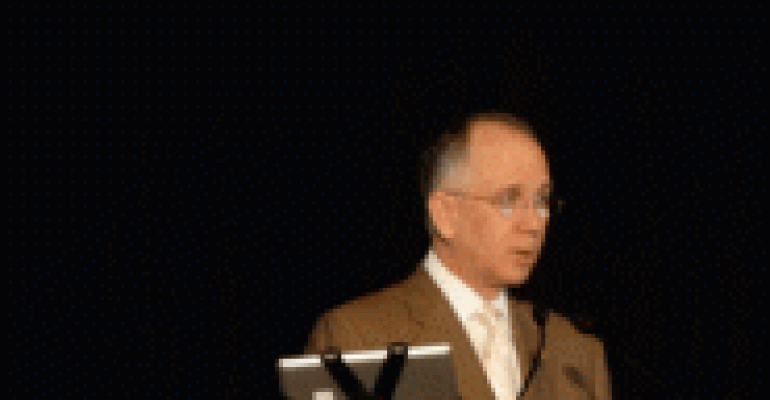I kept forgetting to bring my camera, but I did finally remember to get a few shots on the last day of the National Task Force on CME Provider/Industry Collaboration conference (click to enlarge the thumbnail photos).
Douglas Henley, MD, FAAFP, with the American Academy of Family Physicians, gave the Shickman Lecture: Collaborating for Advances in Professional Education and Patient-Centered Care. He talked about the cacophony of information, guidelines, and data healthcare providers have to contend with, and how med ed professionals can get their attention. For example, he said CME providers should rally behind—and deliver their activities via—plug-and-play, cost-effective healthcare information technology. He also talked about the need for team-based, patient-centered care, and publicly available reporting of conflicts of interest, physician knowledge, treatment options, etc.
I particularly liked this quote: "CME providers can help clinicians understand it's always going to be a journey, and targets will always be moving. But there are measures that matter. We need to pay attention to the disease states that are most important to healthcare today."
He also spent some time talking about how social factors, education, law enforcement, agriculture, and environmental policy all equal health policy, since they are all important factors in healthcare. (I'm not sure I bought all of his arguments on this one, especially when he talked about education levels' correlation with poverty, violence, obesity, smoking, etc.—they're correlated, but does less education cause these things? I don't think he made his case.)
Anyway, it was a thought-provoking talk. Which was followed with a panel discussion led by John Kamp, PhD, JD, with the Coalition for Healthcare Communication.
Kamp led Henley and David Hoyt, MD, American College of Surgeons, and Dave Davis, MD, FCFP, Association of American Medical Colleges, in a discussion of where we are and where we're going. Among the current challenges:
Moving from didactic to using any and all formats that will help docs learn
Moving from physician-centered to team-based activities
Moving from therapeutic-centered topics to prevention, screening, and non-clinical patient treatment
Moving education from the ballroom to workplace learning
Moving from butts-in-seats outcomes to performance and patient health outcomes
Moving from traditional commercial support financial model to more pluralistic models that have all healthcare organizations contributing to CME financing
Moving from CME being a standalone to CME being integrated into the entire organization
Hoyt talked about a surgeon-specific system of educational peer review that allows the surgeons to track their own standings and assess their practices. All in all, it was a good panel discussion, and Kamp kept it on track and provocative.
Here are a few shots from the exhibit area:
On the left is Alexis Weinstein, Healthmatters CME, Colleen Filak, MS, CCMEP, Concordia Healthcare Education (whose tweets I have been enjoying for a while but I hadn't met her until this conference), and Audrie Turnow, CCMEP, Paradigm Medical Communications, who wrote a great column for Medical Meetings last year on how to beat the post-con blues (i.e., how do you actually do something with what you learned once you're back in your real life).
Paul Paul Piché, BSc, MBA, and Martin Robert, PhD, HIT Global Inc. (Piché is also president of the board of the Global Alliance for CME, which he said is holding its 2012 meeting in Toronto the day before the 2012 CME Congress.)
Last but by no means least, here are Wendy Turrell, DrPh, CCMEP, Aspire Health Consulting, Debrah Fisher, Alliance for CME, and Mila Kostic, University of Pennsylvania School of Medicine










